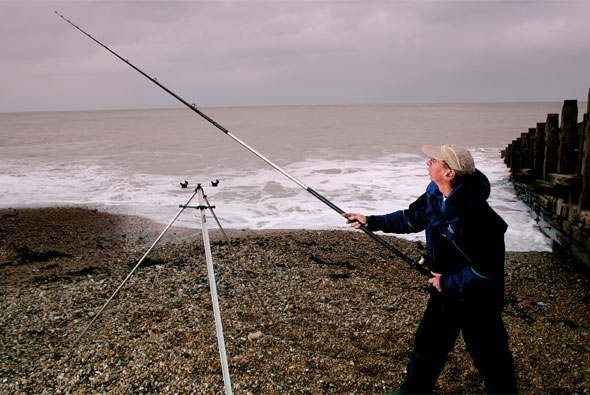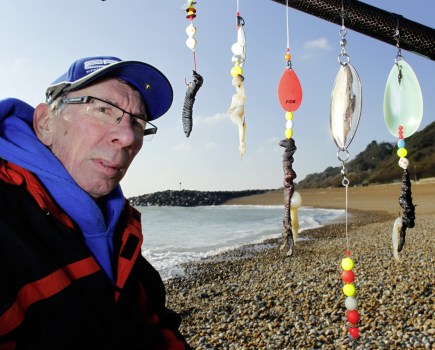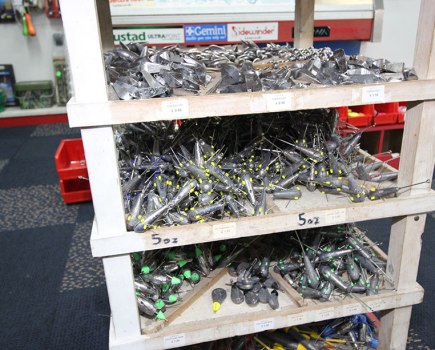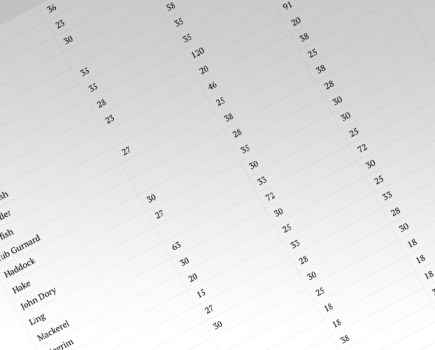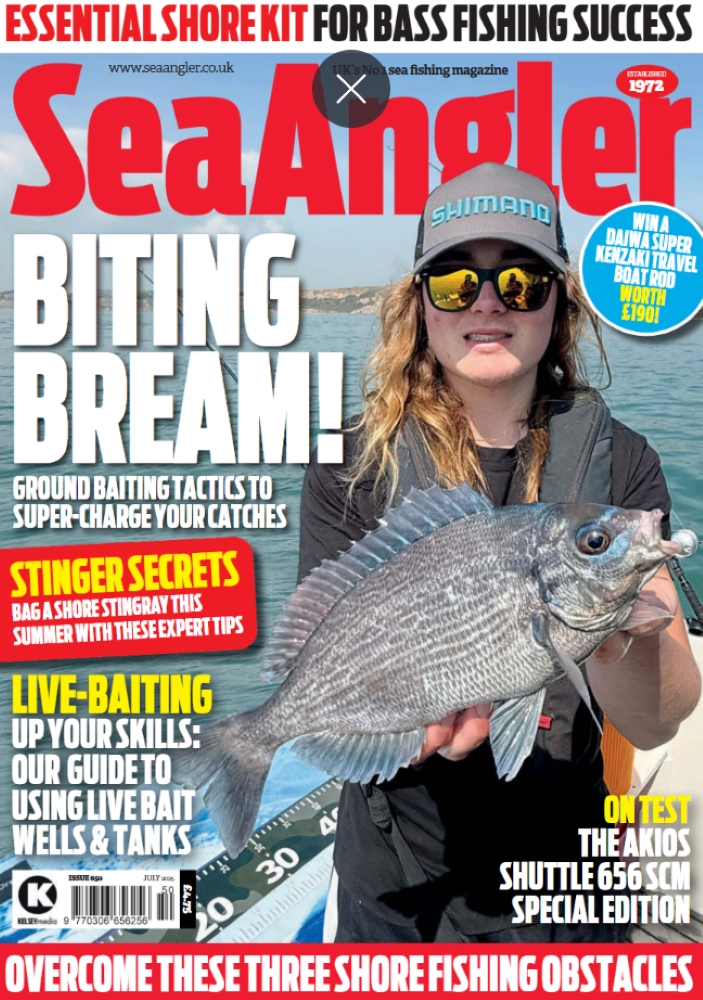STRIKE! Striking lets the sea angler get totally engrossed in the capture of a fish. Like squeezing the trigger of a gun, it’s the crucial moment of the hunt. Here we reveal how, why and when you should sweep the rod round to set the trap
Striking is seen as an important part of angling. If you miss the moment that the fish takes the bait you may not hook it.
However, striking is a bit of a myth because lots of fish hook themselves. We all like to think driving the hook home is crucial to success, but does it really make that much difference to catch rates?
Some fish will rarely be hooked if you don’t strike at the precise moment they take the bait. These are usually species found in clear water or that are super sensitive to hook, line and sinker.
Coarse fish are a classic example, having learnt to avoid hooks because they have been caught and returned before. At sea this problem isn’t so acute, but there are a number of more sensitive species and the grey mullet is one that will rarely hook itself.
Many other sea fish will hook themselves eventually, if you don’t strike, simply because they are intent on eating the bait and are oblivious of the fishing tackle.
The way a fish feeds, what it eats, its mouth structure and its mobility often determine how easy it is to hook. For example, speedy tropical midwater predators are less easy to hook than the bottom grubbers, such as the flatfish. For some species, like flatfish, once the hook has entered the mouth it cannot escape, while others with large hard bony mouths are difficult to hook because the point cannot find a place to penetrate.
More lethargic species with time to circle the bait, actually bite it, take it down and effectively hook themselves. A deliberate strike makes little difference to the catch rate, although it does help prevent deep hooking.
Overall, in UK waters a less enthusiastic approach to striking will result in more fish being hooked with the decision to strike depending on what the angler wants from his sport.
Decide what you are fishing for, the type of bait being used and conservation issues. If the rod is lurching seawards and is in danger of being lost then a strike is essential. If the rod tip is nodding continuously it is likely the fish is already hooked anyway.
A strike can vary from a full-blooded sweep of the rod to just tightening the line. Line stretch at distance reduces the amount of movement at the hook with some anglers even running backwards to pick up the line quicker.
Reeling as you strike can prove more effective but beware of striking too hard, especially at short range when it may test tackle and knots.
COD: A relatively slow, bottom grubber with a large mouth. Swallows the hook when left to eat a deadbait on the sea bed. Powerful rod-pulling bites, usually after the fish has hooked itself. Slack liners from codling can be difficult to hook and the answer is patience. Take up the line and strike when the fish pulls the rod tip down.
WHITING: Hard to hook on occasions, easy on others. They attack in numbers with rod-pulling bites that are easily missed, especially in slack tide. More are hooked in strong tide because the fish have to swim to eat the bait. Once engulfed they relax and the tide drives them back onto the hook. Short snoods and neat bait presentation improves the hooking rate.
BASS: A fast-feeding predator that rarely swallows the hook because the bites are so positive. Be near your rod when it takes off. A bony mouth, so a large, sharp hook is essential.
FLATFISH: Often flatfish peck and nibble at the bait, but once they engulf the bait they are hooked because their mouth is far smaller closed than when open. There is no way to prevent flatties swallowing the hook, with hook removal often fatal, even with soft-wire hooks.
For the conservation minded, tiny hooks (size 8 and less) can be removed more easily with less damage than large ones (size 1+).
SMOOTHHOUNDS AND TOPE: Positive bites give you every opportunity to pull the trigger on this species, which is why they are so popular and fun to catch. The tope is one of the only UK sea species for which circle hooks are really suitable. There is a definite technique for striking with circle hooks and it involves a steady tightening of the line and not a full-blooded strike.
RAYS: Invariably flop on the bait causing the rod tip to tremble. Later the fish moves off, having taken the bait, and pulls down the tip, slackening the line or sometimes pulling the rod over. Rays are often foul hooked outside of the mouth by a premature strike.
BLACK BREAM: Difficult to hook because of their bait pecking and small mouths. Use light tackle and line, plus small hooks. Bait small and carefully, then be patient.
GREY MULLET: Shy away from large hooks and thick line. Bites are often positive, but need to be struck because the fish will expel hook and bait if they feel resistance. Only the thin-lipped mullet is suicidal like many other sea fish. Never strike by sight when fishing for thick-lipped mullet. When you see a fish take the bait, always wait until the float disappears or the tip goes round.
DOGFISH: Difficult to hook. Catch rates can be improved by using a frozen sandeel on a size 1 Aberdeen. Patience is essential, but don’t move the rod or bait once a bite is spotted.
CONGER EELS: Some reckon a conger should be given time to take the bait. This may allow it to swallow the hook, so striking early is best.
STRIKING TIPS
- Holding your rod and gripping the line between the fi ngers allows yoy to feel the tugs from the small species and it’s a fun way to fi sh. Experiment with striking and you will fi nd that, in a majority of cases, catch rates are greatly improved by letting the fi sh bite for a few seconds before hitting it. When using multi-hook rigs to catch fi sh for the pot, letting the fi sh hook themselves is far superior to striking every rod tip rattle.
- If you are going to strike, ensure that the reel is not in free line or on the ratchet and that you have a fi rm footing. More than one angler has struck at a screaming ratchet and fallen on his backside.
- Patience is a virtue and more fi sh will be landed if you take your time and do not rush at the strike. Let the fi sh take the bait and strike early if you intend to release it.
- Braid line and its lack of stretch allows for more positive bite detection and striking. However, your rod needs to be softer to compensate when a powerful fi sh is hooked.
- Bait size and presentation are very important in relation to when you strike. Use a single lugworm on a size 2 hook and you can strike fairly quickly, but with a double squid on a 6/0 Pennell rig you may need to give the fi sh longer to get into the bait. Ensure that baits do not mask a bait. There is no need to hide your hook in the bait.
- A problem for many sea anglers is that they allow the meal to ‘grow’ too big by adding fresh helpings to a washed out bait. Baiting fresh and paying attention to presentation every cast will result in an improved strike and catch rate.
- If in doubt, wait a few seconds before you strike.

